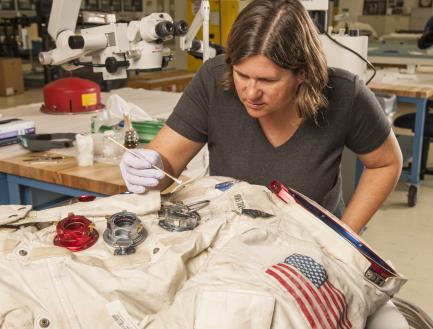
Neil Armstrong’s Spacesuit On Display at National Air and Space Museum for 50th Anniversary of Apollo 11
On the 50th anniversary of the historic launch of Apollo 11, the Smithsonian’s National Air and Space Museum unveiled Neil Armstrong’s Apollo 11 spacesuit, back on display for the first time in 13 years. The suit was conserved, digitized and put back on display in time for the 50th anniversary of the first moon landing thanks to a successful Kickstarter campaign in 2015. It is being temporarily displayed near the 1903 Wright Flyer until its future home, the “Destination Moon” exhibition, is completed in the next few years.
“Neil Armstrong’s spacesuit, the suit that allowed a human to walk on the surface of the moon for the first time, is one of the most iconic artifacts in our collection because of the historical feat Armstrong achieved,” said Ellen Stofan, John and Adrienne Mars Director of the museum. “Just as it took thousands of men and women to accomplish this mission 50 years ago, we’re so proud that thousands of people played a part in getting the spacesuit back on display for the anniversary.”
The conservation of the suit included the creation of a detailed map through the imaging of X-rays, CT scanning and UV photography, as well as years of research. The museum conservators worked to stabilize the suit’s degradation while taking great care not to remove the remains of lunar dust embedded in the exterior fabric. The most important part of the treatment to prolong the life of the suit was to provide a stable environment for the suit’s display.
A state-of-the-art display case and mannequin were created to protect the fragile suit. The case replicates the conditions of climate-controlled storage by tightly controlling temperature, lighting, relative humidity and ventilation. A mannequin was created specifically for this suit, using Armstrong’s actual measurements, and designed to allow air circulation from the case through the mannequin system and into the suit. This advanced circulation system allows unwanted vapors, caused by the breakdown of the rubber in the suit, to be pulled away from the suit over time and slow down degradation.
“The combination of the advanced imagery, historical research and climate-control case allows us to share this suit with the world in a manner that has not previously been possible,” said Cathleen Lewis, spacesuit curator at the museum.
The suit’s conservation and display were made possible by over 9,000 people from around the world through a Kickstarter campaign in 2015. The campaign was the first Kickstarter in Smithsonian history, and the museum hit the $500,000 goal within five days. This method of fundraising allowed more people to participate in the project. No matter the amount, thousands of individuals were able to collectively make the project successful, and each of them received updates throughout the four-year project.
The effort to protect and display Armstrong’s suit also included sharing it with a wider audience. The museum and the Smithsonian’s Digitization Program Office 3-D scanned the suit, helmet and gloves. Through laser-arm scanning, structured light, photogrammetry and medical CT scanning, anyone in the world with an internet connection can now peek inside the suit and take a guided tour of its many complex components. The team has also made the data available so the public can download the high-resolution 3-D model for use in AR/VR platforms, animation software and 3-D printing. The scan data and a tour of the 3-D model are now available.
The museum will be commemorating the Apollo 50th anniversary with a five-day celebration, July 16–20. For more information about all of the museum’s anniversary plans and Apollo historical content, visit https://airandspace.si.edu/apollo50.
The National Air and Space Museum in Washington, D.C., is located at Sixth Street and Independence Avenue S.W. Washington, D.C. The Steven F. Udvar-Hazy Center is located in Chantilly, Virginia, near Washington Dulles International Airport. Both facilities are open daily from 10 a.m. until 5:30 p.m. (closed Dec. 25). Admission is free, but there is a $15 fee for parking at the Udvar-Hazy Center.
# # #
SI-301-2019




